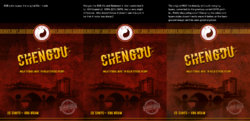Hello people!
I'm new to this forum and sure not an 'advanced' Photoshop user yet.
I am making some labels for some fireworks cakes. I have to do circa 25 cakes. They all have the same style, but with a different image on the front and some other minor differences. I had a great layout with dark-red backgrand and contrasting yellow details. When I was around the 8th label, I totally remembered I was being really dumb: I was working in RGB color profile instead of CMYK!!
I tried to make it CMYK via ISO coated 300% v2, I looked around on the internet and they said that's a good choice... I don't know what they print with in China, so I don't have much of a choice. Still my nice label gets an ugly brown look. I've tried lot's of things with layer styles, but it just won't work out fine. I know RGB is much brighter and saturated then CMYK, but there has to be a way to let my labels at least look a little bit like I head in mind.... I'm really desperate since the labels have to be printed at the begin of june. What if I keep them RGB and print it?
In the link below I have a ZIP file where you can see a RGB and CMYK file. It's kinda messy with layers and stuff, but I really hope someone can look at it and give me tips what to do!
I'm new to this forum and sure not an 'advanced' Photoshop user yet.
I am making some labels for some fireworks cakes. I have to do circa 25 cakes. They all have the same style, but with a different image on the front and some other minor differences. I had a great layout with dark-red backgrand and contrasting yellow details. When I was around the 8th label, I totally remembered I was being really dumb: I was working in RGB color profile instead of CMYK!!
I tried to make it CMYK via ISO coated 300% v2, I looked around on the internet and they said that's a good choice... I don't know what they print with in China, so I don't have much of a choice. Still my nice label gets an ugly brown look. I've tried lot's of things with layer styles, but it just won't work out fine. I know RGB is much brighter and saturated then CMYK, but there has to be a way to let my labels at least look a little bit like I head in mind.... I'm really desperate since the labels have to be printed at the begin of june. What if I keep them RGB and print it?
In the link below I have a ZIP file where you can see a RGB and CMYK file. It's kinda messy with layers and stuff, but I really hope someone can look at it and give me tips what to do!

